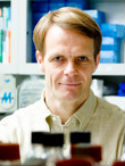Nonhuman primate parthenogenetic stem cells Journal Article
| Authors: | Vrana, K. E.; Hipp, J. D.; Goss, A. M.; McCool, B. A.; Riddle, D. R.; Walker, S. J.; Wettstein, P. J.; Studer, L. P.; Tabar, V.; Cunniff, K.; Chapman, K.; Vilner, L.; West, M. D.; Grant, K. A.; Cibelli, J. B. |
| Article Title: | Nonhuman primate parthenogenetic stem cells |
| Abstract: | Parthenogenesis is the biological phenomenon by which embryonic development is initiated without male contribution. Whereas parthenogenesis is a common mode of reproduction in lower organisms, the mammalian parthenote fails to produce a successful pregnancy. We herein describe in vitro parthenogenetic development of monkey (Macaca fascicularis) eggs to the blastocyst stage, and their use to create a pluripotent line of stem cells. These monkey stem cells (Cyno-1 cells) are positive for telomerase activity and are immunoreactive for alkaline phosphatase, octamer-binding transcription factor 4 (Oct-4), stage-specific embryonic antigen 4 (SSEA-4), tumor rejection antigen 1-60 (TRA 1-60), and tumor rejection antigen 1-81 (TRA 1-81) (traditional markers of human embryonic stem cells). They have a normal chromosome karyotype (40 + 2) and can be maintained in vitro in an undifferentiated state for extended periods of time. Cyno-1 cells can be differentiated in vitro into dopaminergic and serotonergic neurons, contractile cardiomyocyte-like cells, smooth muscle, ciliated epithelia, and adipocytes. When Cyno-1 cells were injected into severe combined immunodeficient mice, teratomas with derivatives from all three embryonic germ layers were obtained. When grown on fibronectin/laminin-coated plates and in neural progenitor medium, Cyno-1 cells assume a neural precursor phenotype (immunoreactive for nestin). However, these cells remain proliferative and express no functional ion channels. When transferred to differentiation conditions, the nestin-positive precursors assume neuronal and epithelial morphologies. Over time, these cells acquire electrophysiological characteristics of functional neurons (appearance of tetrodotoxin-sensitive, voltage-dependent sodium channels). These results suggest that stem cells derived from the parthenogenetically activated nonhuman primate egg provide a potential source for autologous cell therapy in the female and bypass the need for creating a competent embryo. |
| Keywords: | controlled study; unclassified drug; nonhuman; conference paper; animal cell; mammalia; animals; embryo; cell line; nerve tissue proteins; transcription factor; embryo development; cell differentiation; neurons; immunoreactivity; telomerase; animalia; stem cell; gene expression regulation, developmental; alkaline phosphatase; dna; antigen; pluripotent stem cells; immune deficiency; genes, mhc class ii; monkey; macaca; karyotype; nestin; heart muscle cell; intermediate filament proteins; dopaminergic nerve cell; adoptive immunotherapy; smooth muscle; blastocyst; macaca fascicularis; adipocyte; primates; ion channel; parthenogenesis; genes, mhc class i; tumor rejection antigen; stage specific embryo antigen 4; serotoninergic nerve cell; male; female; priority journal; embryonic and fetal development |
| Journal Title: | Proceedings of the National Academy of Sciences of the United States of America |
| Volume: | 100 |
| Issue: | Suppl.1 |
| ISSN: | 0027-8424 |
| Publisher: | National Academy of Sciences |
| Date Published: | 2003-09-30 |
| Start Page: | 11911 |
| End Page: | 11916 |
| Language: | English |
| DOI: | 10.1073/pnas.2034195100 |
| PUBMED: | 14504386 |
| PROVIDER: | scopus |
| PMCID: | PMC304106 |
| DOI/URL: | |
| Notes: | Export Date: 25 September 2014 -- Source: Scopus |
Altmetric
Citation Impact
BMJ Impact Analytics
Related MSK Work





